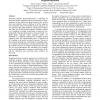Free Online Productivity Tools
i2Speak
i2Symbol
i2OCR
iTex2Img
iWeb2Print
iWeb2Shot
i2Type
iPdf2Split
iPdf2Merge
i2Bopomofo
i2Arabic
i2Style
i2Image
i2PDF
iLatex2Rtf
Sci2ools
ISMB
1993
1993
Computationally Efficient Cluster Representation in Molecular Sequence Megaclassification
Molecular sequence megaclassification is a technique for automated protein sequence analysis and annotation. Implementation of the method has been limited by the need to store and randomly access a database of all the sequence pair similarities. More than 80,000 protein sequences are now present in the public databases, and the pair similarity data table for the full protein sequence database requires over 1 gigabyte of storage. In this paper we present a computationally efficient representation of groups based on a graph theory approach where sequence clusters are described by a minimal spanning tree of highest scoring similarity pairs. This representation allows a classification of N proteins to be stored in order(N) memory. The use of this minimal spanning tree representation simplifies analysis of groups, the description of group characteristics and the manual correction of artifacts resulting from false hits. The new tree representation also introduces new possibilities for artif...
Computational Biology | ISMB 1993 | Minimal Spanning Tree | Protein Sequence | Protein Sequence Analysis |
| Added | 02 Nov 2010 |
| Updated | 02 Nov 2010 |
| Type | Conference |
| Year | 1993 |
| Where | ISMB |
| Authors | David J. States, Nomi L. Harris, Lawrence Hunter |
Comments (0)

